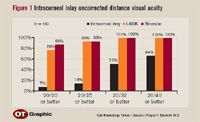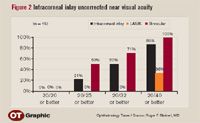Article
Corneal inlay is versatile approach for presbyopia
Las Vegas-A small intracorneal inlay (PresbyLens, ReVision Optics) may be an option for LASIK patients who have developed presbyopia, said Roger F. Steinert, MD, during a spotlight session on the management of presbyopia here at the American Academy of Ophthalmology annual meeting.

The device has potential to treat presbyopia in virtually any candidate, including an emmetropic presbyopic patient, a prior LASIK patient, or in conjunction with a patient who needs a distance-correcting myopic or hyperopic LASIK procedure.

"The [corneal inlay] embodies the key attributes of a presbyopic treatment," Dr. Steinert said. "The material has proven to have long-term corneal compatibility. It is an additive procedure, which is good for plus powers. Also, it is adjustable and removable, if needed."

Thirteen females and two males received the intracorneal inlay in their non-dominant eyes after LASIK ablation for myopia. The mean manifest refractive spherical equivalent (MRSE) for the pre-inlay eye was –2.72 ± 0.68 D, and the mean MRSE for the pre-LASIK eyes was –2.71 ± 1.01 D. In addition, the mean pre-inlay add was +1.72 ± 1.31 D and the mean pre-LASIK add was +1.70 ± 1.38 D, Dr. Steinert said.
At 3 months postop, an uncorrected distance visual acuity (UCDVA) of 20/32 or better was achieved in all eyes, and an uncorrected near visual acuity of 20/40 or better binocularly also was achieved in all eyes.
"We found that a little loss of the higher levels of distance vision occurs with the [inlay]," Dr. Steinert noted. "However, distance visual acuity is less affected by the inlay than monovision."
Newsletter
Don’t miss out—get Ophthalmology Times updates on the latest clinical advancements and expert interviews, straight to your inbox.




